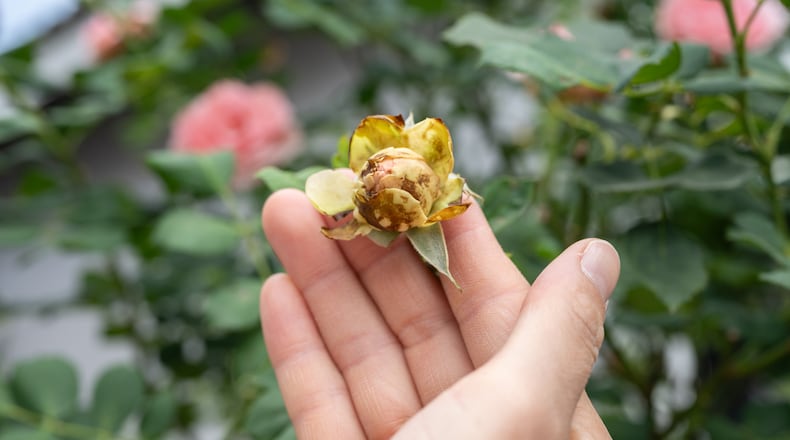This fungus causes diseases on twigs, leaves and blossoms. It affects plants through injured sites. It affects flowers as they begin to senesce and on decaying fruits. Perhaps you have seen this in your refrigerator?
Several years ago, we saw botrytis on Asiatic lilies during a particularly cool, wet spring. The damage was primarily on the leaves, but also the blooms.
I usually see it on peonies. The primary symptoms are blackened buds that don’t open or blossom blight. You can also have bud rot, stem canker, stem and crown rot, and leaf blight.
The problem with botrytis on peony is that the infection occurs at the time plants are emerging from the ground. In addition, applying fungicides is almost impossible because of timing. You must apply fungicides every 10 days during the infection period.
For botrytis on your annual flowers, deadheading (removing the dying flowers) helps to remove inoculum and prevent further infection.
This is a common disease in greenhouses on annuals and perennials. This weather is conducive for development. Cool nights, no sun, and plants are growing under crowded conditions.
Good air circulation is important. If you haven’t planted your annual flowers (because the soil is too wet!), keep them spread out and in the sunniest space possible. Dry them down as much as possible.
Botrytis, like all other diseases, has three components necessary for it to emerge. The first is the pathogen, which is in the environment. It’s hanging out in a variety of places — on the plants, on plant debris, in the ground, and in other places.
The second component is the plant which we plant into our landscapes. When the plant and pathogen are present, you only have two pieces of what is known as the disease triangle.
The critical component for a disease to emerge is the environment. Each disease has a specific environmental condition that causes it to emerge. In the example of botrytis, the conditions are cool and damp.
Controlling diseases using fungicides is challenging. Timing is everything. The fungicide must be on the surface of the plant before the pathogen infects it. Symptoms may not show up until days after the infection. If you miss that window, you won’t stop the disease development.
You can manipulate the plant in some cases by selecting disease-resistant plants. These are specific to their disease. For instance, tall phlox is susceptible to powdery mildew; therefore, purchase a resistant variety.
You can manipulate the environment for some diseases by providing good air circulation, good planting practices, and keeping water off the foliage. However, this can be challenging as well.
Learning about the three components, called the disease triangle, helps to manage diseases in the landscapes.
Credit: Getty Images
Credit: Getty Images
Pamela Corle-Bennett is the state master gardener volunteer coordinator and horticulture educator for Ohio State University Extension. Contact her by email at bennett.27@osu.edu.
About the Author


